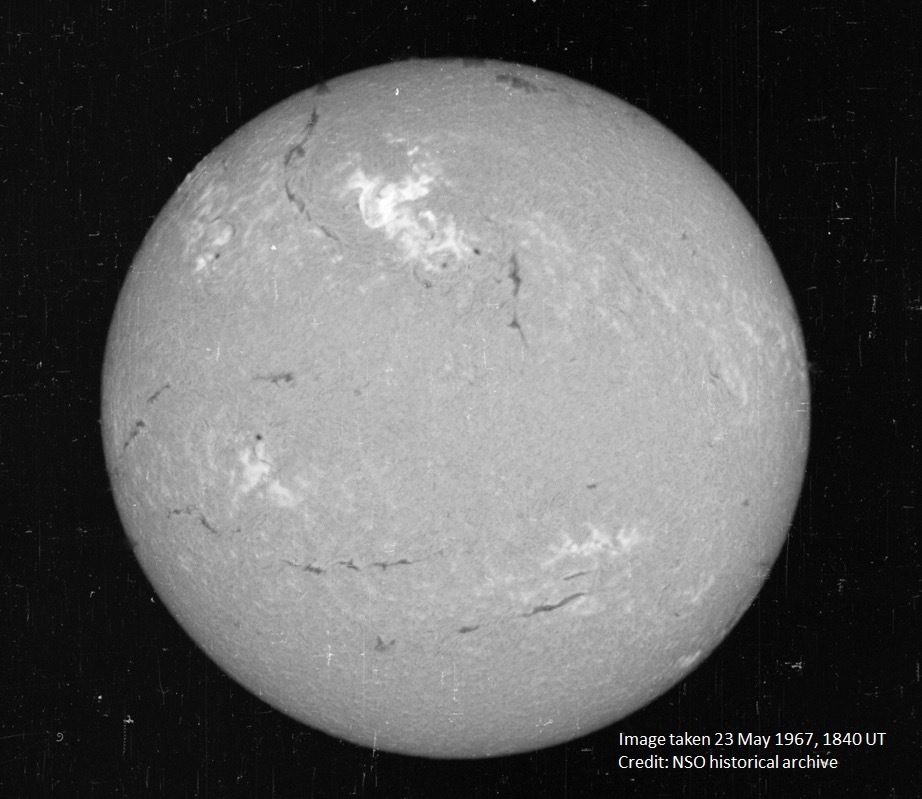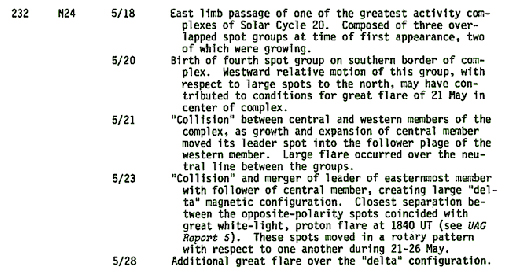
A powerful solar storm nearly heated the Cold War up catastrophically a half century ago, a new study suggests.
The U.S. Air Force began preparing for war on May 23, 1967, thinking that the Soviet Union had jammed a set of American surveillance radars. But military space-weather forecasters intervened in time, telling top officials that a powerful sun eruption was to blame, according to the study.
"Had it not been for the fact that we had invested very early on in solar and geomagnetic storm observations and forecasting, the impact [of the storm] likely would have been much greater," Delores Knipp, a space physicist at the University of Colorado Boulder and the study's lead author, said in a statement. "This was a lesson learned in how important it is to be prepared." [The Sun's Wrath: Worst Solar Storms in History]
Frightening false alarm
The storm began brewing on May 18, 1967, when researchers noticed a big group of sunspots with strong magnetic fields clumped on one part of the solar disk.
Sunspots — dark, relatively cool areas on the sun's surface — serve as launching pads for powerful bursts of high-energy radiation known as solar flares, as well as eruptions of solar plasma called coronal mass ejections (CMEs), which almost always accompany strong flares.
Intense flares that hit Earth can disrupt radio transmissions and satellite communications, among other effects. Earth-directed CMEs can be even more damaging; big ones can spawn "geomagnetic storms" that blow out transformers in power grids, for example.
On May 23, 1967, the sun fired off a flare so powerful that it was visible to the naked eye, and began emitting radio waves at a level that had never been seen before, study team members said.
Get the world’s most fascinating discoveries delivered straight to your inbox.
That same day, all three of the Air Force's Ballistic Missile Early Warning System radar sites in the far Northern Hemisphere — which were located in Alaska, Greenland and the United Kingdom — appeared to be jammed.
Air Force officials initially assumed that the Soviet Union was responsible. Such radar jamming is considered an act of war, so commanders quickly began preparing nuclear-weapon-equipped aircraft for launch. (These newly scrambled aircraft would have been "additional forces," according to the study authors; the U.S. kept nuke-bearing "alert" planes aloft pretty much continuously throughout the 1960s.)
"This is a grave situation," Knipp said. "But here's where the story turns: Things were going horribly wrong, and then something goes commendably right."
Those additional forces never launched. So what happened? Solar forecasters at the North American Aerospace Defense Command (NORAD) — a joint U.S.-Canadian effort that looks out for incoming missiles and other possible threats — and elsewhere figured out that the flare, not the Soviets, had disrupted the radars. (The U.S. military had begun keeping tabs on solar activity, and its effects on Earth, in the 1950s; by 1967, NORAD was getting daily updates on the subject, study team members said.)
Knipp and her colleagues think this information made it in time to Air Force commanders and other high-ranking officials — including, perhaps, President Lyndon Johnson.
"Oftentimes, the way things work is, something catastrophic happens, and then we say, 'We should do something so it doesn't happen again,'" Morris Cohen, an electrical engineer and radio scientist at the Georgia Institute of Technology in Atlanta, said in the same statement. "But in this case, there was just enough preparation done just in time to avert a disastrous result," added Cohen, who was not involved in the new study.
A solar superstorm
The flare on May 23, 1967, was accompanied by a CME, which hit Earth about 40 hours later. (CMEs travel through space at millions of miles per hour — fast, but not nearly as fast as solar-flare radiation, which, of course, moves at the speed of light.)
The CME triggered a powerful geomagnetic storm, which disrupted American radio communications for nearly a week, study team members said. This storm also ramped up the northern lights, making them visible as far south as New Mexico.
"As a magnetospheric disturbance, the 25-26 May event ranks near the top in the record books," Knipp and her colleagues wrote in the new study, which has been accepted for publication in the journal Space Weather.
You can read a copy of the paper for free here.
The top spot in the record books, incidentally, likely belongs to the famous Carrington Event of September 1859. That geomagnetic storm caused telegraph systems to fail all over North America and Europe, and the northern lights were visible as far south as the Caribbean.
A Carrington-like storm today would likely be devastating, given how much more dependent the world is on technological infrastructure such as power grids and satellite networks, experts have said.
Follow Mike Wall on Twitter @michaeldwall and Google+. Follow us @Spacedotcom, Facebook or Google+. Originally published on Space.com.



